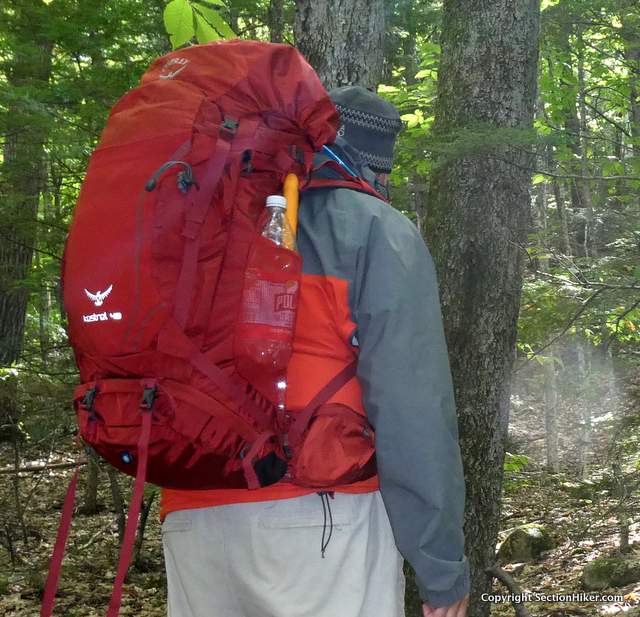The Osprey Kestrel 48 is a lightweight backpack that’s well-sized for thru-hiking and weekend backpacking trips with moderate loads. Weighing 3 lbs and 5.3 ounces (size M/L), the Kestrel has many of the features you find on higher volume backpacks without the overhead of more weight. The 48L Kestrel is also a great pack to use if you’ve switched to lower volume ultralight backpacking gear but still want a pack that has a lot of pockets and organization options.
Specs at a Glance
- Gender: Men’s (Women’s version is the Kyte 46)
- Type: Internal frame, wire perimeter loop
- Weight (without rain cover): 3 lbs 3.7 oz (S/M), 3 lbs 5.3 oz (M/L)
- Rain cover (optional, included): (4.7 oz)
- Torso range: 16″-23″, two sizes available
- Waist/hip range: 27″-55″, two sizes available
- Closed pockets: 7+ main compartment
- Open pockets: 3
- Material: 210 denier ripstop nylon
- Bear canister compatible: Yes, vertical
- Max Recommended load: 35 pounds
Backpack Storage and Organization
The Osprey Kestrel 48 has a top lid, main compartment, sleeping bag pocket, front mesh pocket, and side water bottle pockets. The top lid is sewn to the front of the pack and has two pockets, one on top, and an internal mesh pocket facing the top of the main compartment. The main compartment closes with a drawstring, but does not have a hydration pocket. Instead, there’s a gap behind the shoulder straps for storing a reservoir, so you don’t have to unpack and repack your backpack every time you need to refill it. It’s super easy to use and a key differentiator, if you’re comparing merits of the Kestrel 48 to other backpacks.

There are two full length zippers on the sides of the pack. The right side zipper opens into the main compartment so you can reach in and pull gear out without having to stop, open it from the top, and unpack. The left hand zipper opens to a full length pocket that’s ideal for stowing a rain coat, sweater, or hats and gloves that you want to keep in covered storage but easily accessible. There’s also a separate sleeping bag compartment at the base of the pack at the bottom of the main compartment. The top of the sleeping bag pocket is really a fold away shelf, that you can release if you’d rather pack the man compartment as one large space. An optional rain cover is also housed underneath the sleeping bag pocket in a small zippered pocket at the bottom of the backpack.

There’s a mesh shove-it pocket on the front of the pack, but it’s not that large. I put my Sawyer water filter, squeeze bag, snacks, and wet gear into it, but it’s not quite large enough for a wet 2 person tent.
The side water bottle pockets are also mesh and are sized to hold 1 liter Nalgene bottles. I can’t reach them when I’m wearing the pack. If you normally use a hydration system, this won’t be an issue. But if you prefer using water bottles, this could be a showstopper if you don’t like to stop every time you want a drink.

Backpack Frame
The Kestrel is an adjustable frame backpack, which means you can change the torso length by raising or lowering the shoulder pads. For example, raising the shoulder pads will the length between them and your hips, while lowering them will decrease it. The shoulder pads are connected to the backpack by velcro so to raise and lower them, you simply release and reposition them where you want.
The pack has a lightweight wire frame that runs around the perimeter of the pack. The back area behind your shoulder blades isn’t ventilated like a trampoline pack, but it is covered with die-cut foam and mesh to help cool your back and keep it drier.

The Kestrel’s hip belt is sewn the back of the pack. The hip belt wings are padded with wicking mesh and the hip belt has two solid-faced, zippered pockets, one on each side. They’re well sized and I can store my iPhone and some bars or a point and shoot camera in them.

Compression and External Attachment System
The Kestrel 48 has two tiers of compression straps on the sides of the pack. Both straps open and close with buckles, making it easy to lash snowshoes or even skis to the sides of the pack.
The front of the pack also comes with sleeping pad straps, so you can secure a pad or tent to the bottom of the pack if you need extra storage. The straps hang down behind you, but are removable if you don’t want to use them.
There are also gear loops all over the pack that you can attach more gear to, including loops on the top pocket (4), and 8 loops on the sides of the front mesh pocket, that can act like daisy chains if you prefer to lash gear there. The Kestrel also has Osprey’s Stow-on-the-Go trekking pole retainer.

Recommendation
The Osprey Kestrel 48 is loaded with features that make it really easy to use for thru-hiking, weekend backpacking and more technical hikes. Despite its small volume and light weight, it has a lot of organizational features normally found on larger and heavier backpacks. With an adjustable length frame and torso range of 16″ to 23″, it’s also available for smaller men and ones with much longer torsos, who can have problems finding a well-sized backpack.
Compare 5 Prices
-

 Amazon US$220.00View
Amazon US$220.00ViewAmazon.com Price: $220.00 (as of 04/16/2024 12:02 GMT-0400) Details
Product prices and availability are accurate as of the date/time indicated and are subject to change. Any price and availability information displayed on Amazon.com at the time of purchase will apply to the purchase of this product.
-

 Sportsman's Warehouse$220.00View
Sportsman's Warehouse$220.00View -

 Backcountry.com$220.00View
Backcountry.com$220.00View -

 Eastern Mountain Sports$220.00View
Eastern Mountain Sports$220.00View -

 Osprey Packs$220.00View
Osprey Packs$220.00View
Disclosure: The author purchased this backpack.
SectionHiker is reader-supported. We only make money if you purchase a product through our affiliate links. Help us continue to test and write unsponsored and independent gear reviews, beginner FAQs, and free hiking guides. SectionHiker.com Backpacking Gear Reviews and FAQs
SectionHiker.com Backpacking Gear Reviews and FAQs 
Would you recommend this as a winter day pack?
I’d get the Osprey Mutant 38 if you wanted a real winter day pack. But yes you could use this or the kestrel 38 for winter just fine.
https://sectionhiker.com/osprey-mutant-backpack-38-review/
Thanks-do you not mind the fact that the mutant 38 and 52 do not have hip pockets?
That’s the point. You hang things from them with carabiners or attach pockets to the shoulder strap daisy chains. So no. Doesn’t bother me a bit. You know all those gear loops clothing manufacturers put on gloves and jackets. That’s what they’re for. Backpack hip belt pockets freeze and ice up in winter. Very hard to use if you have to keep your gloves on.
Makes sense. Thank you!